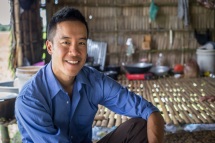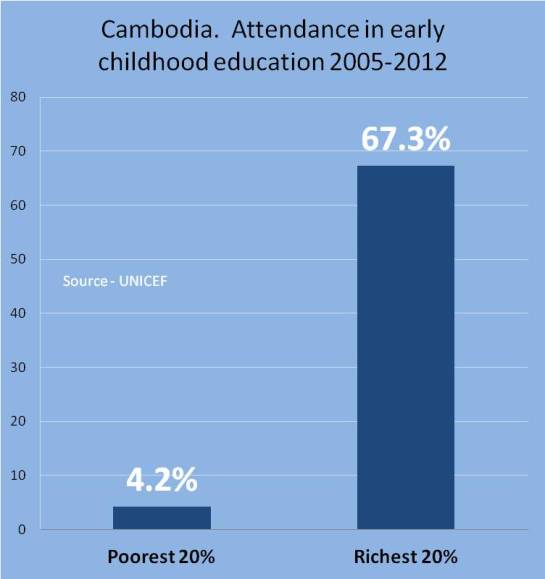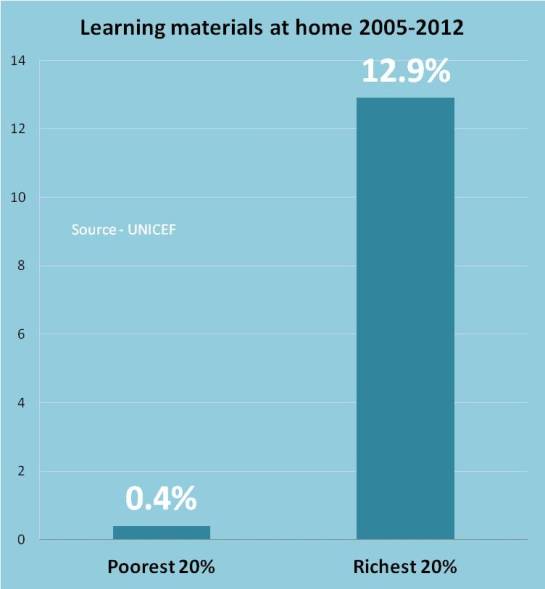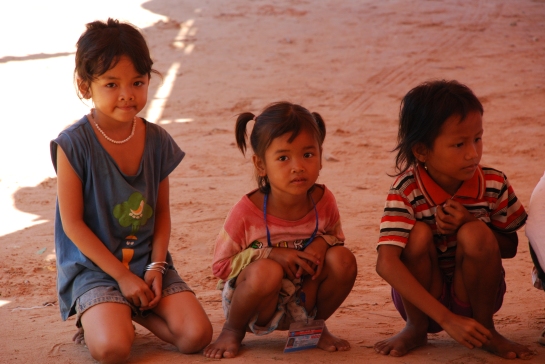
Weh Yeoh – the objective is not to build an NGO, but to get results. In this interview he describes how he is helping facilitate a local solution to a problem that affects 600,000 Cambodians – those with speech or swallowing difficulties.
Weh Yeoh, is an Australian on a vivid mission in Cambodia and I interviewed him in early 2005. He was Managing Director, OIC: The Cambodia Project and this comparatively recent NGO start-up is worth paying attention to – not only for the work it is doing – with a focus on training speech therapists, but in the manner it has structured itself to operate.
In reviewing this article in 2019 I remain impressed by Weh’s clarity of thinking and in some ways disruptive viewpoint regarding charitable organisations. The purpose is not to grow these, he says, but to make themselves redundant.
1. First of all, congratulations on starting OIC. These things don’t happen overnight – how did you personally get involved and what motivated you to start this work in Cambodia?
I’ve always been enamoured by the power of local people in poor countries to create change for themselves. In my first year in Cambodia, I worked with CABDICO, a local disability organisation, and I realised how few resources these organisations have. And yet, the best work is being done by these people.
While first working with CABDICO, I met a child named Ling two years ago. He’s an outgoing, intelligent child, in a poor village in rural Cambodia. Ling has cerebral palsy, damage that occurs in a young brain around the time of birth. As
a result, he had problems speaking to the point where his language wasn’t clear at all.
When I met Ling, he was 10 years old and he had never been to school. He couldn’t read or write, or even bathe himself. He couldn’t communicate clearly and was completely dependent on his family.
Those around him labelled him “chqoot” – a Cambodian word meaning “stupid” or even “retarded”. Simply put, without help, Ling’s only way of earning an income would be a life of begging.
Around the same time, I also met Phearom, Ling’s community worker from CABDICO, who visits him at his home every few weeks. As part of our pilot program, we trained Phearom on speech therapy. This training taught her how to treat Ling’s communication problem. It has had a truly life-changing impact on his life.
For the first time, Ling could speak with his family. But Phearom didn’t stop there. She brought Ling’s teachers together to discuss how to get Ling into the classroom. After months of hard work, Ling is now going to school, but not only that, he is coming number two in his class. He dreams of one day becoming an architect. Ling now has a future, because of speech therapy.
Meeting Ling two years ago taught me a valuable lesson. There are children all over Cambodia whose potential is being untapped because of a communication or swallowing problem. Often, all it takes is a little bit of help and a child’s future can be improved dramatically.
That’s why, with the assistance of a small group of dedicated Australian speech therapists lead by Dr Chyrisse Heine, I began the first pilot program in speech therapy in Cambodia with CABDICO, a little over a year ago. The program has now evolved to be OIC: The Cambodia Project. “OIC” refers to that moment when you suddenly understand something that you didn’t before. Oh I see, you would say. My idea was never to start another non-profit organisation when there are so many goodCambodian organisations doing great work. Hence, the project is part of CABDICO’s existing work.
2. Tell me a little bit about speech and swallowing difficulties. What are the various causes for these – and are there cures, or is it more a case of assisting children to live and cope with these difficulties?
There are many causes of communication and swallowing disorders, including intellectual disabilities, brain trauma and strokes. These kinds of problems can affect anyone from a child with autism, to a middle-aged motorbike accident victim, to an elderly person who has had a stroke.
Because of the diversity of these disorders, there is no one “cure” and the goals of treatment are different for every person.
As one famous example of someone with a communication problem, James Earl Jones, the voice of Darth Vader, grew up stuttering. Though he has obviously had a lot of success in overcoming his stutter, he says he still stutters and he doesn’t say he was cured. But he is certainly able to communicate like anyone else.
Obviously, this a less severe example of a communication problem. On the other hand, for someone who has an intellectual disability and can’t speak, success may look like teaching them how to use various communication aids so they can still communicate with others. It really differs from person to person.
With swallowing difficulties, again the range of causes is very diverse. Whether it is a physical problem or a problem with the nervous system, the person’s ability to swallow food or liquid in a way that you and I take for granted is impaired. This means that often, the substance will go into the lungs, and the person is at risk of contracting pneumonia. As a result, they’re 13 times more likely to die young.
For people like this, their ability to swallow may improve, but otherwise, speech therapy works to mitigate some of these risks through altering positioning, or the consistency of food or liquid, for example.
3. You publish a very frightening figure – 600,000 children in Cambodia have speech or swallowing difficulties. Where does that number come from? – health statistics from Cambodia are not always reliable.
As you rightly point out, health data in Cambodia is often poor. However, there are some good statistics about the number of people with disabilities who have communication problems as a percentage of the total population with disabilities in Cambodia. According to the World Health Organisation, at least 15% of people in any country have a disability, which means that 2.1 million out of Cambodia’s 14.3 million people have a disability of some kind. Cambodian official statistics state that 5% of people with disabilities have a speaking impairment, and 20% have a hearing impairment. There is no data on swallowing impairments. Applying these percentages to the 2.1 million people with a disability, we can estimate that there are at least 600,000 Cambodians (including both adults and children) with a communication or swallowing problem.
This figure represents 4% of the population, however it is probably a conservative estimate, given rates of disability are higher in developing countries. In my own country of Australia, the estimate is somewhere between 4 to 8% of the population. In order to address this population, Australia has over 6,000 speech therapists. However, in Cambodia, there are none. There is not one university-trained Cambodian speech therapist.
4. Children with real communication difficulties can be hard work for their families. What is the general story for these children – are they well supported by their families?
Great question. For disability workers, it’s incredibly important to work with the families as well as the children; in fact, it’s just as important as working with the child, given how much more time children spend with their families. I think many families who have children with disabilities can feel overwhelmed and helpless.
They don’t know how to best care for their children. It’s often an incredible relief when they receive support from disability workers, and I think they find it very encouraging to learn how they can best support their children. Many of the families are incredibly patient and supportive, such as Mai’s family, which we’ve written about on our website.
5. Before forming OIC you ran a pilot scheme with local NGO: CABDICO. What did the pilot scheme teach you? How did this modify your approach?
Well, the first thing we learned is that speech therapy really does help. Preliminary research we did earlier in the year showed us that speech therapy increased the number of children who could communicate with their family most of the time from one in five to four in five. That’s a huge jump.
We’re currently undergoing an independent evaluation of our program, and will use these lessons learnt to inform the next stage of our work in Cambodia. It’s important that we use this evidence based approach, because we’re doing something that has never been done before. We want to evaluate the effectiveness of speech therapy in Cambodia, to show that it can help that enormous population of 600,000 people who need it.
6. What are the main objectives of OIC?
We have two goals:
1 – to provide training in speech therapy services across Cambodia
2 – to graduate the first generation of Cambodian speech therapists from a Cambodian university
As you know, we’ve already begun training in speech therapy, and we are in the early stages of discussing with a Cambodian university beginning a speech therapy program.
7. You and the team have a very clear mission not just to work with individual children, but to effectively multiply your skills – by training local Cambodians in speech therapy. How did you arrive at this strategy? Did you work with local Cambodians to develop the strategy?
Since I arrived in Cambodia, the one lesson I’ve learnt the most is that it is Cambodian people who are creating real change in this country for themselves. Our role as foreigners should be to support them as best as possible. My colleagues who have had decades of experience working in disability have told me since day one that the lack of speech therapy is the biggest gap in health and disability services in the country.
My goal is to work our team out of a job. If our long term vision is for delivery of speech therapy services in Cambodia, this means that as foreigners, we cannot be the ones implementing speech therapy. In order to do this, we’ll need to train local Cambodians on speech therapy.
But to take that one step further, it’s even better if Cambodians are training other Cambodians in speech therapy. Our training program will use a train the trainers approach, where we will train local Cambodians to be the trainers. Eventually, we’ll have Cambodians teaching the university course as well. Once the entire teaching team is run by Cambodians, we’ll have a sustainable way to spread this knowledge in Cambodia. Then, we won’t need foreign volunteers to train Cambodians on speech therapy. It will be Cambodians, learning from other Cambodians. We don’t just value Cambodian input – we know it’s absolutely critical to the success of the project.
8. In terms of mainstream teaching, the styles of teaching differ quite widely when you compare Khmer and Western approaches. Have you in the team discovered differences between the Australian approach and the way locals operate?
What we’ve noticed in our training sessions is that the Western inclination is to start from a fairly academic, theoretical perspective, while Cambodians prefer very practical approaches. We’ve had to make sure we adapt so that they can take away the practical skills they need to immediately improve their ability to deliver speech therapy. It’s interesting too to see how speech therapy changes dependent on the culture and context.
As one example, there is an Australian list of the 50 first words a child learns to say. This list cannot just be translated into Cambodian, as words like “water buffalo” are on the Cambodian list but not on the Australian one. Again, this goes back to how important it is to have Cambodians involved in every aspect of the project. Taking an Australian speech therapy resource or program and transplanting it in Cambodia is not going to work.
9. How much of a support network does OIC enjoy in Phnom Penh? Do other NGOs contribute in the overall dialogue – or are you mostly head down working on your own program?
The key to our success is in working with Cambodian organisations that already work in this field. We don’t implement services; we train people at organisations that are already providing services. This means strong relationships with others, including non-profit organisations, hospitals, and government departments, is essential. They have the disability workers, the relationships in the community, and the knowledge of Cambodia. Up to two years ago, all they were missing is knowledge of speech therapy.
We want to build on the great work these organisations are doing, rather than create another NGO.
10. How can speech therapists (or speech pathologists) reading this best assist you and your work at OIC. For example if I was a speech therapist wishing to volunteer, what would be a suitable and realistic time frame?
There are a whole range of ways that speech therapists can get involved. We need help with training, curriculum, research, resources and fundraising just to name a few areas. Though I’m not a speech therapist myself (I originally trained as a physiotherapist a long time ago), I’ve come to appreciate just how generous speech therapists are with their time and energy. We’ve already benefitted from the generosity of speech therapists all over the world, and this is just the beginning. Depending on their availability, we’d welcome speech therapists interested in volunteering from home or in Cambodia. We’d love them to get in touch via our website.
11. Weh – your work and approach are remarkable. When did you realise that foreign service was your calling?
Though I really appreciate the compliment, I don’t consider anything that I do to be particularly remarkable. What is more remarkable is to see what Cambodian people can do for other Cambodians.
 I spent six months of my life, in 2006, volunteering in an orphanage and adult shelter for people with disabilities in Vietnam. It was disastrous. I was a young, naive 24 year old with good intentions but no clue of what I was doing. One year later, I went back to Australia and started working with a great little organisation that helped people with disabilities. More importantly, I went back to university to study International Development, to try and work out how to do this thing – “helping people in poor countries” better. I learnt a huge amount that I didn’t know when volunteering in the orphanage. Since coming to Cambodia, I’ve realised that there are so many challenges to overcome here. And yet, colleagues of mine, like Phearom, have shown me what they are capable of doing with very little resources, very little pay but a lot of energy and passion. What Phearom has been able to achieve with Ling is simply remarkable.
I spent six months of my life, in 2006, volunteering in an orphanage and adult shelter for people with disabilities in Vietnam. It was disastrous. I was a young, naive 24 year old with good intentions but no clue of what I was doing. One year later, I went back to Australia and started working with a great little organisation that helped people with disabilities. More importantly, I went back to university to study International Development, to try and work out how to do this thing – “helping people in poor countries” better. I learnt a huge amount that I didn’t know when volunteering in the orphanage. Since coming to Cambodia, I’ve realised that there are so many challenges to overcome here. And yet, colleagues of mine, like Phearom, have shown me what they are capable of doing with very little resources, very little pay but a lot of energy and passion. What Phearom has been able to achieve with Ling is simply remarkable.
There is a pervasive myth that it is foreigners like myself who are creating change in poor countries. The reality couldn’t be further from the truth. I tried to be the person making the change while volunteering in the orphanage. That didn’t work. Studying development and working in Cambodia has taught me that my role is to support those people making the change, like my Cambodian colleague, Phearom.
Once this became clear to me, there was no other way to work anymore. OIC’s approach builds very much upon this philosophy, giving Cambodians the tools and resources to help other Cambodians.
12. OIC Cambodia Project. The name suggests a finite lifespan for the organisation. At what point do you say, right, mission accomplished?
We absolutely want there to be a finite lifespan for the organisation. When there is speech therapy knowledge within the country, and when Cambodians are able to train other Cambodians on speech therapy, we are no longer needed. I can’t wait for that day, when every one of the 600,000 people who need access to these services will be able to access them – and from Cambodian speech therapists, who understand their language and culture.
And who knows, then it might be time for OIC: The Laos Project!
- For further information about the OIC project: a Cambodia-based charity helping Cambodians with communication and swallowing problems. Click here: http://oiccambodia.org/
- Find Weh Yeo on twitter https://twitter.com/wmyeoh






You must be logged in to post a comment.